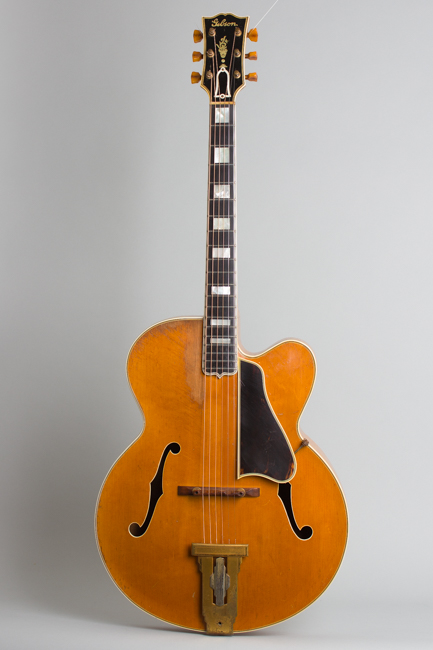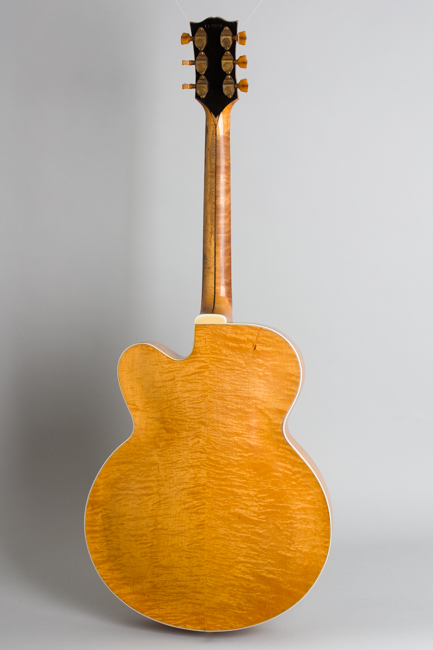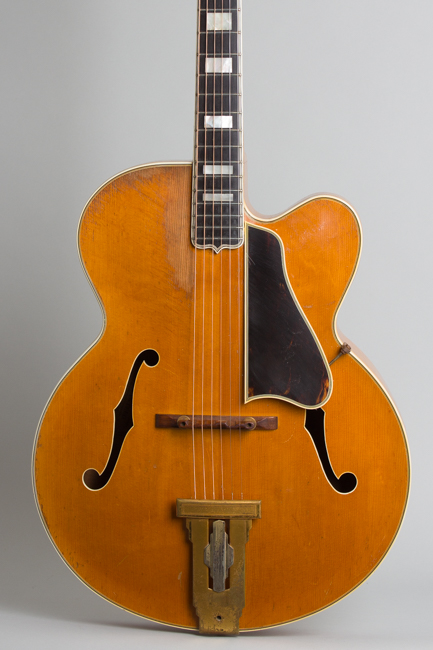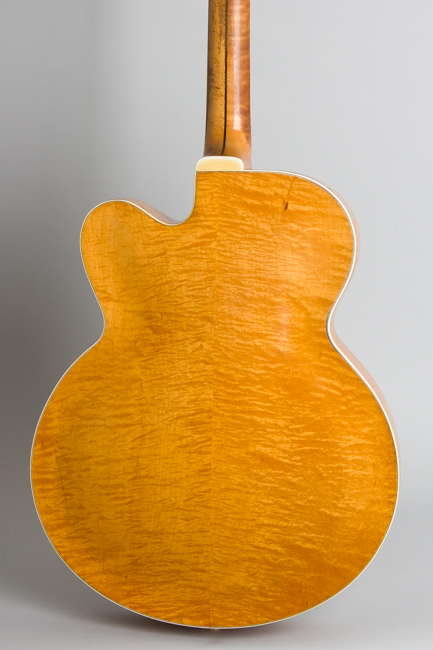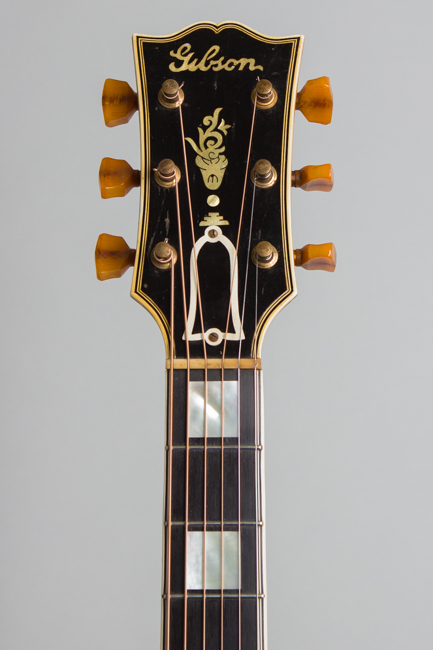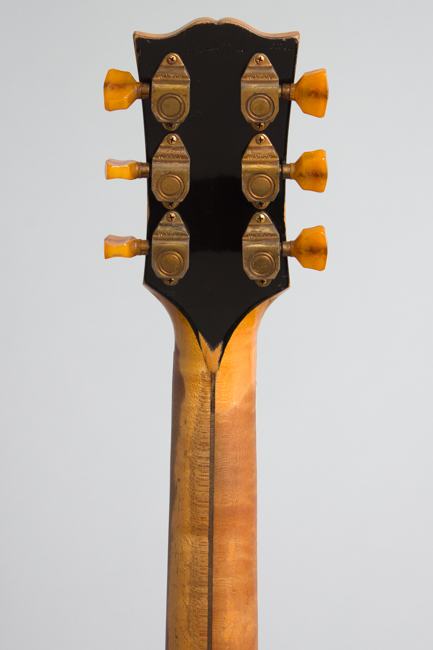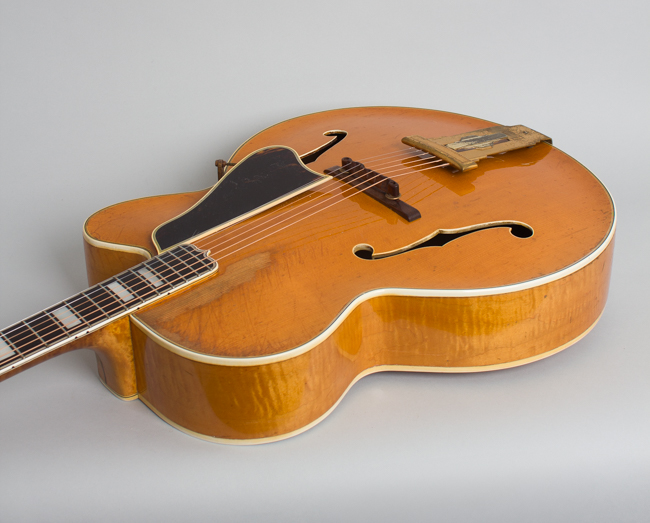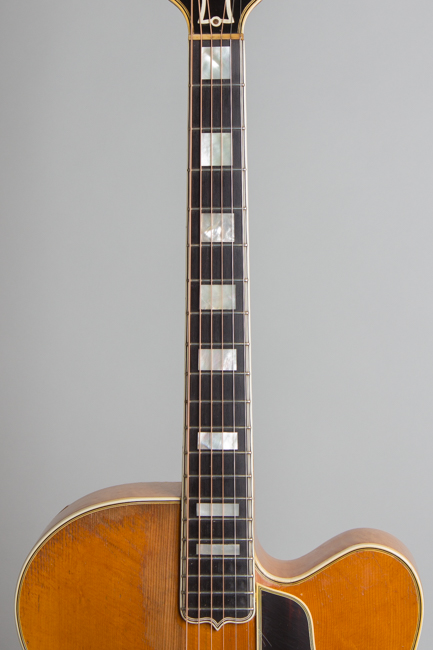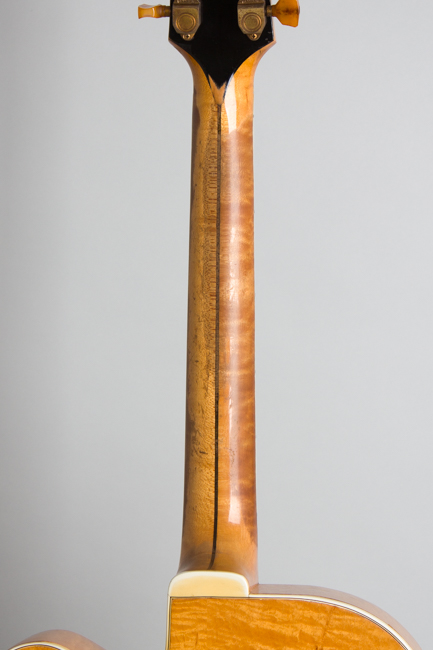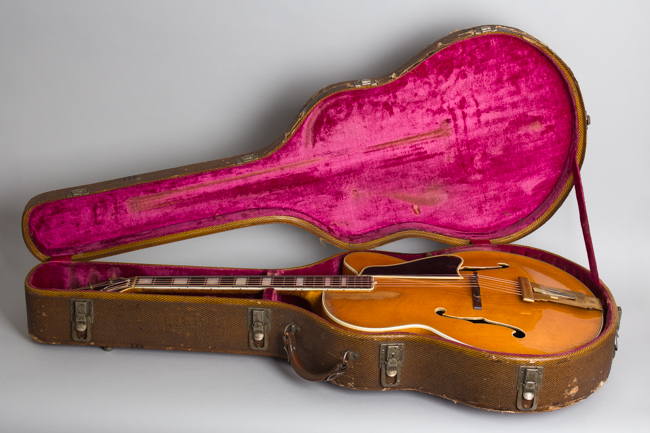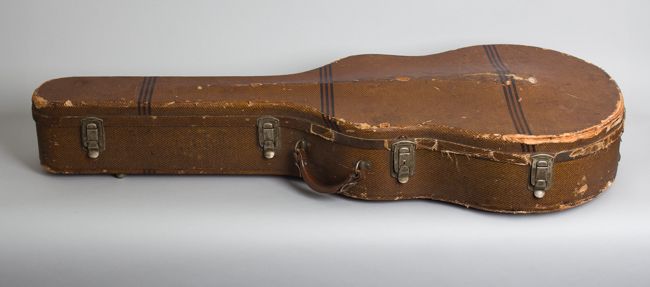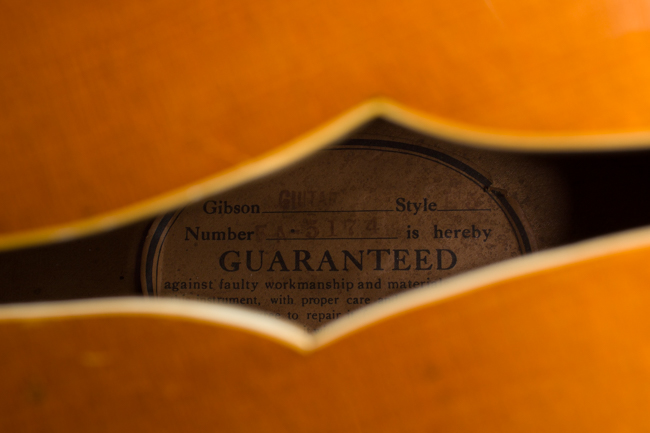Gibson L-5 PN Arch Top Acoustic Guitar (1940)
Gibson L-5 PN Model Arch Top Acoustic Guitar (1940), made in Kalamazoo, Michigan, serial # FA-5174, natural lacquer finish, flame maple back and sides with spruce top; laminated maple neck with ebony fingerboard, original tweed hard shell case.
This well-worn but largely original guitar is both a fantastic playing and sounding instrument and an important piece of Gibson history-one of the earliest cutaway L-5's ever made. This body design with the rounded "Venetian" cutaway on the treble bout became a Gibson staple and has been copied by virtually every other guitar maker since. This single-cutaway design was a milestone in guitar evolution, elegantly allowing the player much more fingerboard access and its origin began right here. Gibson had experimented with cutaway instruments before 1910 with the elaborately-scrolled Style O Artist Model, but the 1939 "Premier" L-5's and Super 400s represent the birth of the modern cutaway guitar.
The company's new "Premier" L-5 and Super 400 were officially announced in the 1940 "Catalog AA" but examples had already been produced in late 1939; one is already shown in an artist endorsement picture. Gibson's L-5 had been in production since 1924, and the "Advanced" 17" wide version appeared in 1935. While after 1934 the guitar had been officially superseded by the Super 400 as the absolute top-of-the-line, the L-5 was still highly popular with professional users, many of whom found the 17" guitar to be better handling (and often better sounding) instrument compared to the 18" Super 400.
The options of the cutaway and natural finish were both new 1940 when this guitar was made, one of only around 40 shipped that year. Estimates indicate that something like a grand total of 53 natural-finish, cutaway L-5's were shipped up through 1943 when the last one left Kalamazoo. After the war, the model was re-instated but the "Premier" designation was soon dropped in favor of the more prosaic "cutaway" designation. Pre-war L-5 Premiers like this one represent some of the finest purely acoustic cutaway archtops the company ever built. Gibson had reverted to parallel bracing on the L-5 by 1939, and all these Premier models are built this way.
This guitar itself has some interesting features. The serial number FA-5174 (on the label and stamped on the headstock) is from a distinct "Artist" series used only on some high-end instruments in 1939-40; it dates the guitar to 1940. The Factory order number is not clearly stamped but also includes the "F" suffix used that year. An unusual construction element on these first cutaway guitars is the fingerboard is not elevated off the top, but resting directly on the guitar's face more like a flat top. This may have been because Gibson's engineers were unsure of how well the heelblock would be supported with the rim cut away on one side; the reason is lost to time. Whatever the rationale, by 1941 Gibson's cutaway archtops reverted to the standard cantilevered fingerboard found on their full-body cousins. This guitar also features some of the earliest Kluson Sealfast tuning machines with beautiful amber Catalin buttons.
This guitar was a top-line showpiece for Gibson in 1940 and all workmanship is to an extremely high standard, as are the woods. The back is finely grained bookmatched flame maple, the rims showing some flame figure as well. The cutaway itself is interesting looking hand-shaped, with a slight effect of opening outwards towards the face of the guitar. The top in the cutaway actually bends down a bit to meet the binding in a beautifully executed piece of carving.
The neck is carved to a superbly comfortable "C" profile with some flame figure to the wood as well, the fingerboard is a very fine dark piece of ebony with the elaborate 5-ply binding very neatly executed. At the time this guitar was built the top-line "Orchestra Guitars" were far more important to the company than flat tops or electrics, and this was Gibson's definitive modernistic statement. Every progressive big band and broadcasting guitarist was a prospective customer, and Gibson was treating their top competitor Epiphone with a one-two punch by simultaneously introducing the cutaway and gleaming natural blonde finish. This one appears to have found a serious professional home and served for years as a hard-gigging guitar, exactly as intended.
Overall length is 42 1/4 in. (107.3 cm.), 17 in. (43.2 cm.) wide at lower bout, and 3 3/8 in. (8.6 cm.) in depth, measured at side of rim. Scale length is 25 1/2 in. (648 mm.). Width of nut is 1 11/16 in. (43 mm.).
This 80+ year old historic guitar has been very heavily played but not damaged beyond the effects of decades of use and countless 4-to-the-bar downstrokes. The finish remains all original and unaltered, showing wear just about everywhere but most heavily to the top above the fingerboard. Unlike most higher-grade archtops, the top in this area is close to the plane of the fingerboard; in this case the player's pick strokes have worn deeply into the wood in that upper quarter of the face. The sides have numerous dings and scratches, while the back is surprisingly clean (this guitar was not played standing up with a belt buckle!). The back of the neck is heavily worn to the wood along much of the entire length and on the heel; whoever played this L-5 used the entire fingerboard!
There are not many repairs. The top shows a very small grain split from an impact just above the tailpiece. While the "Vari-tone" (A/K/A "Top buster adjustor") mounted in the tailpiece has dug a bit into the wood, there are no large seam cracks there as sometimes occurred. The lower back has one ancient small grain split near the apex of the lower bout. Some of the back/edge seams have been resealed; there are a couple tiny grain checks on the upper bout side where it meets the back where the wood has pulled up a tiny bit.
All fittings on the guitar remain original except for a later replaced pickguard; the original is in case pocket badly decomposed. There is fairly heavy wear to the gold plating, especially on the pickguard bracket and tailpiece. The guitar looks to have been refretted long ago with appropriate wire; the fingerboard was likely trued as well. This is simply a lovely and majestic guitar to play, effortless with a sound that resonates freely and is both sweet and supple for a straight-braced L-5. The original tweed "Aeroplane Cloth" case is heavily worn from being carried to countless gigs but still intact and functional. Overall Very Good + Condition.
This well-worn but largely original guitar is both a fantastic playing and sounding instrument and an important piece of Gibson history-one of the earliest cutaway L-5's ever made. This body design with the rounded "Venetian" cutaway on the treble bout became a Gibson staple and has been copied by virtually every other guitar maker since. This single-cutaway design was a milestone in guitar evolution, elegantly allowing the player much more fingerboard access and its origin began right here. Gibson had experimented with cutaway instruments before 1910 with the elaborately-scrolled Style O Artist Model, but the 1939 "Premier" L-5's and Super 400s represent the birth of the modern cutaway guitar.
The company's new "Premier" L-5 and Super 400 were officially announced in the 1940 "Catalog AA" but examples had already been produced in late 1939; one is already shown in an artist endorsement picture. Gibson's L-5 had been in production since 1924, and the "Advanced" 17" wide version appeared in 1935. While after 1934 the guitar had been officially superseded by the Super 400 as the absolute top-of-the-line, the L-5 was still highly popular with professional users, many of whom found the 17" guitar to be better handling (and often better sounding) instrument compared to the 18" Super 400.
The options of the cutaway and natural finish were both new 1940 when this guitar was made, one of only around 40 shipped that year. Estimates indicate that something like a grand total of 53 natural-finish, cutaway L-5's were shipped up through 1943 when the last one left Kalamazoo. After the war, the model was re-instated but the "Premier" designation was soon dropped in favor of the more prosaic "cutaway" designation. Pre-war L-5 Premiers like this one represent some of the finest purely acoustic cutaway archtops the company ever built. Gibson had reverted to parallel bracing on the L-5 by 1939, and all these Premier models are built this way.
This guitar itself has some interesting features. The serial number FA-5174 (on the label and stamped on the headstock) is from a distinct "Artist" series used only on some high-end instruments in 1939-40; it dates the guitar to 1940. The Factory order number is not clearly stamped but also includes the "F" suffix used that year. An unusual construction element on these first cutaway guitars is the fingerboard is not elevated off the top, but resting directly on the guitar's face more like a flat top. This may have been because Gibson's engineers were unsure of how well the heelblock would be supported with the rim cut away on one side; the reason is lost to time. Whatever the rationale, by 1941 Gibson's cutaway archtops reverted to the standard cantilevered fingerboard found on their full-body cousins. This guitar also features some of the earliest Kluson Sealfast tuning machines with beautiful amber Catalin buttons.
This guitar was a top-line showpiece for Gibson in 1940 and all workmanship is to an extremely high standard, as are the woods. The back is finely grained bookmatched flame maple, the rims showing some flame figure as well. The cutaway itself is interesting looking hand-shaped, with a slight effect of opening outwards towards the face of the guitar. The top in the cutaway actually bends down a bit to meet the binding in a beautifully executed piece of carving.
The neck is carved to a superbly comfortable "C" profile with some flame figure to the wood as well, the fingerboard is a very fine dark piece of ebony with the elaborate 5-ply binding very neatly executed. At the time this guitar was built the top-line "Orchestra Guitars" were far more important to the company than flat tops or electrics, and this was Gibson's definitive modernistic statement. Every progressive big band and broadcasting guitarist was a prospective customer, and Gibson was treating their top competitor Epiphone with a one-two punch by simultaneously introducing the cutaway and gleaming natural blonde finish. This one appears to have found a serious professional home and served for years as a hard-gigging guitar, exactly as intended.
Overall length is 42 1/4 in. (107.3 cm.), 17 in. (43.2 cm.) wide at lower bout, and 3 3/8 in. (8.6 cm.) in depth, measured at side of rim. Scale length is 25 1/2 in. (648 mm.). Width of nut is 1 11/16 in. (43 mm.).
This 80+ year old historic guitar has been very heavily played but not damaged beyond the effects of decades of use and countless 4-to-the-bar downstrokes. The finish remains all original and unaltered, showing wear just about everywhere but most heavily to the top above the fingerboard. Unlike most higher-grade archtops, the top in this area is close to the plane of the fingerboard; in this case the player's pick strokes have worn deeply into the wood in that upper quarter of the face. The sides have numerous dings and scratches, while the back is surprisingly clean (this guitar was not played standing up with a belt buckle!). The back of the neck is heavily worn to the wood along much of the entire length and on the heel; whoever played this L-5 used the entire fingerboard!
There are not many repairs. The top shows a very small grain split from an impact just above the tailpiece. While the "Vari-tone" (A/K/A "Top buster adjustor") mounted in the tailpiece has dug a bit into the wood, there are no large seam cracks there as sometimes occurred. The lower back has one ancient small grain split near the apex of the lower bout. Some of the back/edge seams have been resealed; there are a couple tiny grain checks on the upper bout side where it meets the back where the wood has pulled up a tiny bit.
All fittings on the guitar remain original except for a later replaced pickguard; the original is in case pocket badly decomposed. There is fairly heavy wear to the gold plating, especially on the pickguard bracket and tailpiece. The guitar looks to have been refretted long ago with appropriate wire; the fingerboard was likely trued as well. This is simply a lovely and majestic guitar to play, effortless with a sound that resonates freely and is both sweet and supple for a straight-braced L-5. The original tweed "Aeroplane Cloth" case is heavily worn from being carried to countless gigs but still intact and functional. Overall Very Good + Condition.
